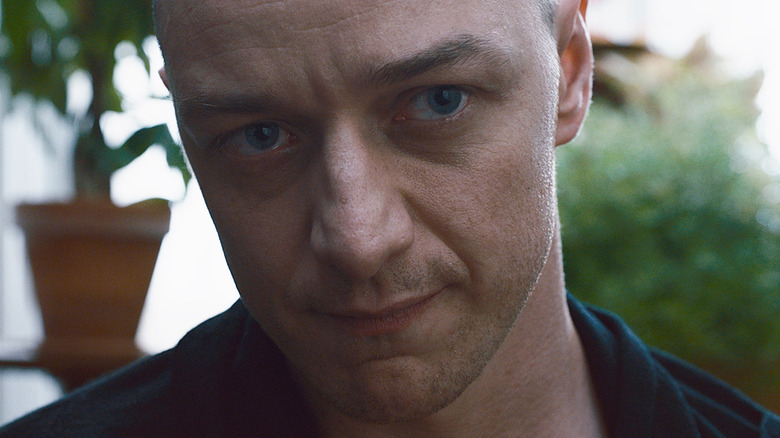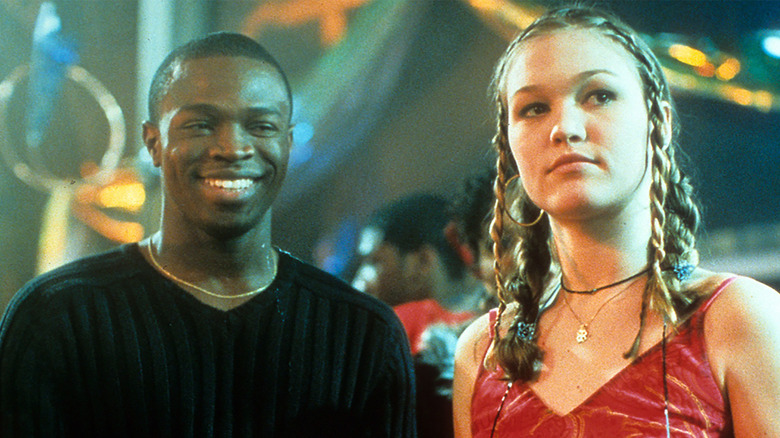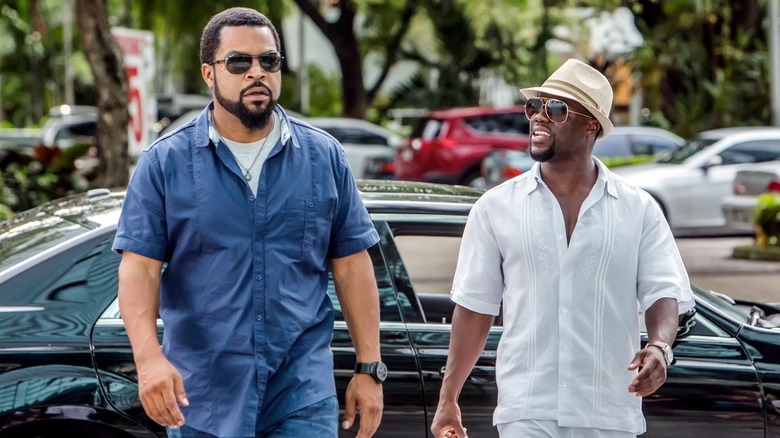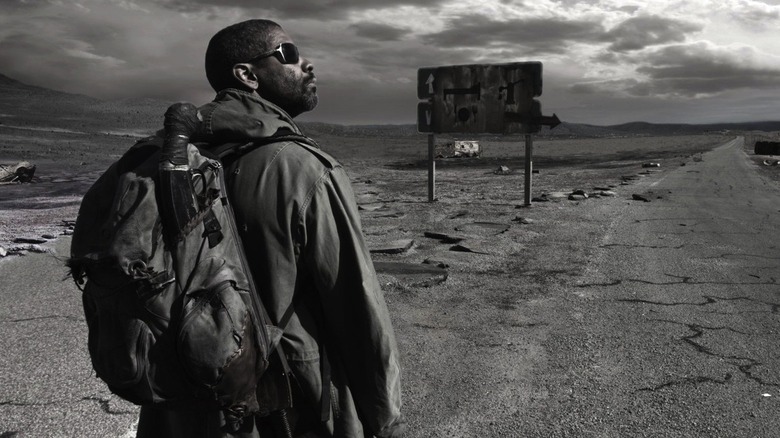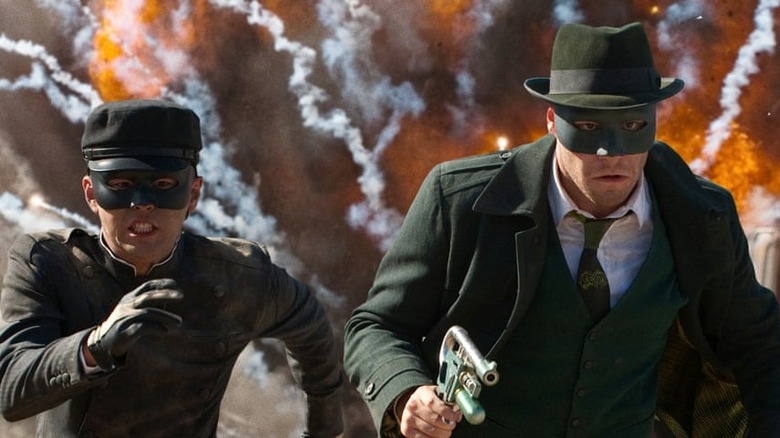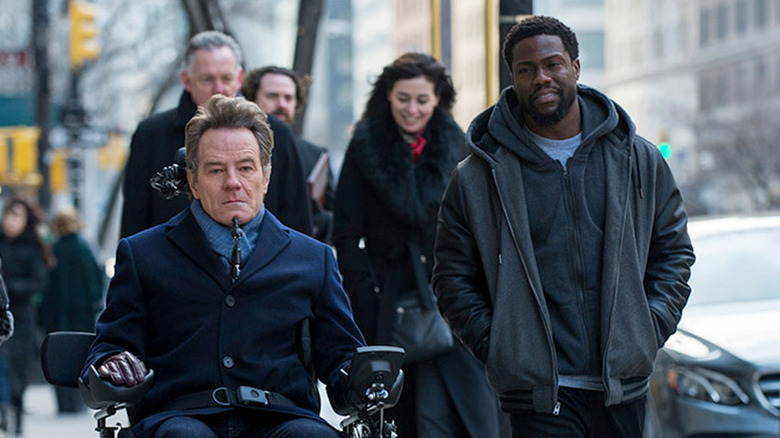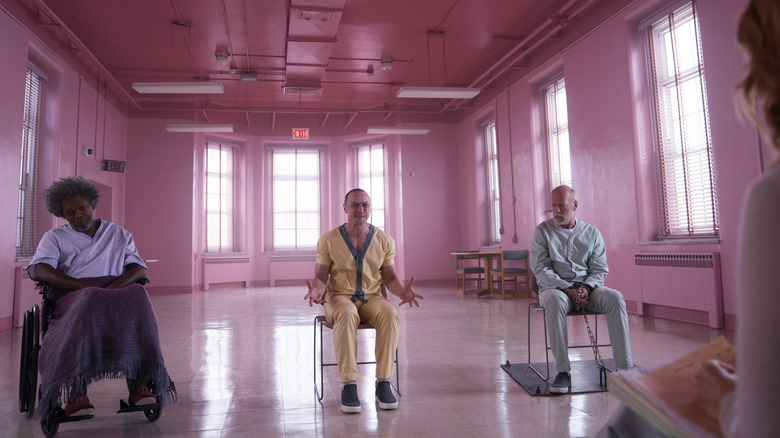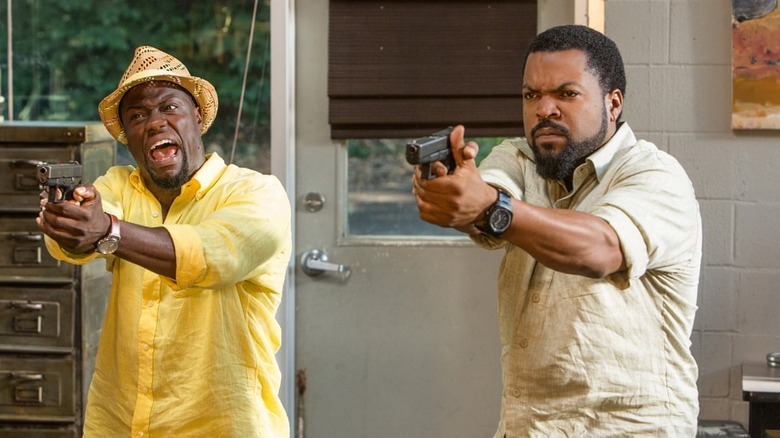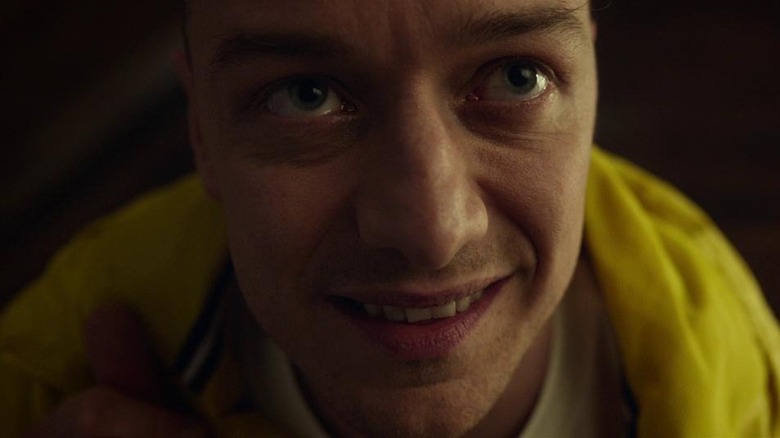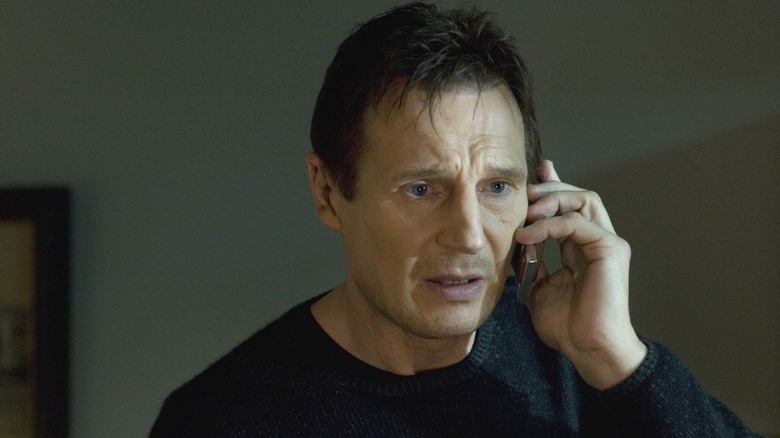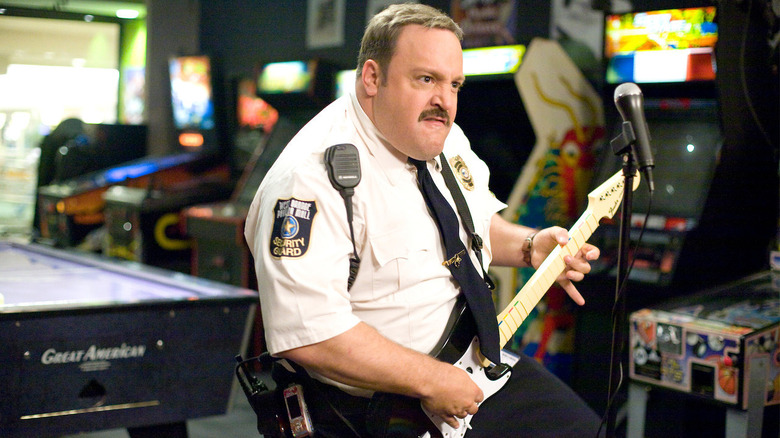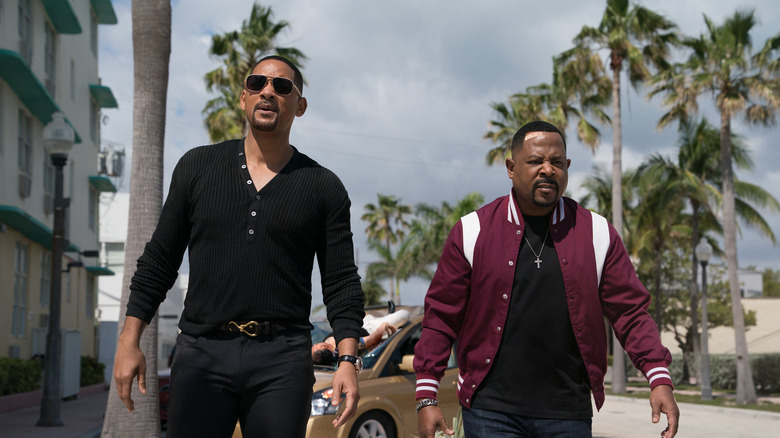The Biggest Movies Ever Released In January
January does not have a good reputation when it comes to delivering new movies. All over the internet, you can easily find memes and comments disparaging January releases as inherently being inferior. This negative perception extends to its box office reputation, with January rarely delivering financial performers on par with those seen in, say, May or December. But that doesn't mean the month is always worth writing off. In fact, over the years, January has been home to plenty of smash hits, some of them even well-reviewed, that have proven people will come out in droves to see something appealing in the first month of a new year.
Because January isn't a go-to place to launch superhero movies or other blockbusters, this month has often been home to offbeat fare that would get lost elsewhere in the year. This means the most lucrative projects of January have ranged wildly from an influential dance film to some M. Night Shyamalan thrillers to even an unlikely hero who saved a mall. January may not be known for delivering masterpieces, but the biggest movies ever at the domestic box office released in January indicate that, if nothing else, this month can churn out some financial titans.
One note before diving into this rundown; only films released directly into theaters in January are included here. This means movies that went limited in December but then went into wide release in January, such as "American Sniper" or "1917," are not covered.
Save the Last Dance
In the 2000s, there was a trend of dance movies that briefly swept the domestic box office. Though "Step Up" ended up being the most notable brand name from this era of the dance film, the title that helped kick off the trend was the January 2001 release "Save the Last Dance." A tale of romance and teenagers expressing rebellion through dance, with a soundtrack featuring everyone from P!nk to Ice Cube, this was unquestionably a 2000s dance movie. All that was missing was somebody in the movie gawking over how cool and fresh Napster was.
Reviews for "Save the Last Dance" were mixed, with primary critiques centered on how the project was too derivative of other movies and that the dialogue was cheesy. The familiarity and unabashedly cornball qualities of "Save the Last Dance," though, were just what audiences wanted out of a dance movie, especially teenage moviegoers who weren't as familiar with classic features like "Dirty Dancing." Costing only $13 million to make, "Save the Last Dance" ended up being an uber-profitable investment that grossed $91 million in North America alone. Given how it was basically a license to print money, it should be no surprise that the 2000s were chock full of movies attempting to make the "Save the Last Dance" lightning strike twice.
Ride Along 2
Some January movies enter the box office landscape drenched in uncertainty. Will these movies be able to make it? Will their premises resonate with audiences? For "Ride Along 2," no such concern plagued its box office expectations. This, after all, was a sequel to the wildly successful "Ride Along." That movie dominated the box office and birthed Kevin Hart as a movie star. Another adventure promising more antics between Hart and Ice Cube was bound to make even more cash for distributor Universal Pictures.
Dropping just two years after its predecessor, "Ride Along 2" grossed $91.2 million domestically, down 32% from the original feature's North American haul, but still solid for a $40 million-budgeted comedy. If there was a key reason for why "Ride Along 2" didn't perform closer to the first film's box office total, it may have just been due to a mild case of Kevin Hart burnout. In the two years between "Ride Along" installments, Hart had starred in four different comedies, with each one featuring the actor at the heart of their respective marketing campaigns. The comedian's big fan base ensured that "Ride Along 2" would never flop or even underperform, but his ubiquity would explain why this sequel felt a touch less special than it normally would have.
The Book of Eli
In the wake of the debut of "Avatar," it seemed like no movie, save for "Sherlock Holmes" on Christmas Day 2009, could topple this film's reign atop the domestic box office charts. While it would take until February 2010 for something to dislodge "Avatar" for an entire weekend, the middle of January 2010 saw a new release manage to dethrone "Avatar" for a single day. Though those Na'vi would end up reclaiming the champion's crown for the entire weekend, "The Book of Eli," on its opening day, secured the number one spot at the box office in North America. James Cameron's bombastic cosmic vision was a powerful allure for moviegoers, but it clearly could get challenged by people's love for Denzel Washington.
That was the key ingredient that led to "The Book of Eli" becoming a sleeper hit at the box office. Washington is a reliable box office draw, especially when it comes to action movies. A marketing campaign that promised moviegoers the sight of Washington wandering a post-apocalyptic wasteland and fighting villains led by Gary Oldman did the trick for teeing up a box office hit. In addition to dethroning "Avatar" for a single day, "The Book of Eli" further impressed with its box office prowess by accumulating $94.8 million at the domestic box office.
The Green Hornet
In retrospect, "The Green Hornet" was ahead of the curve. This superhero movie cast Seth Rogen as its titular crime-fighting lead, a decision that came off as peculiar in 2011. But in the modern film landscape, where Chris Pratt and Paul Rudd can headline entire superhero movie franchises, "The Green Hornet" seems eerily prescient. Unfortunately for those involved in this Rogen star vehicle, "The Green Hornet" couldn't match the box office prowess of Pratt and Rudd's superhero forays, even if this title didn't do terribly for a January release.
In its January 2011 run, "The Green Hornet" managed to gross $98.7 million in North America. It also proved to be the fourth-biggest live-action film Rogen had appeared in up to that point and at the time of its release had the third-largest January opening weekend ever. The problem here was the film's budget, which grew to $110 million during post-production. That was considerably more than your average Rogen comedy vehicle as well as typical January releases ("Taken," by contrast, cost only $25 million to produce). With those exorbitant costs, "The Green Hornet" was not the box office slam-dunk it seemed like on paper, but at least it zoomed past most other January releases.
The Upside
"The Upside" did not have an easy road to the big screen. Originally premiering on the film festival circuit in the Fall of 2017, it was originally set to be released in theaters in March 2018 by The Weinstein Company. However, the studio went belly-up in the wake of the avalanche of accusations leveled at Harvey Weinstein, leaving "The Upside" and several other films without a distributor. Eventually, "The Upside" would receive a new domestic home in the form of STX Films, which proceeded to debut it in theaters in mid-January 2019.
It was a solid release slot for the title, given that one of the movie's stars, Kevin Hart, had headlined several successful features that had opened at this time of the year. The actor's January hot streak continued nicely with "The Upside," which opened atop the North American box office with a $20.1 million haul, the first time an STX title managed to debut in the number one spot in this territory. "The Upside" stuck around for quite a while in theaters and eventually grossed $108.2 million. Among other accomplishments, this makes "The Upside" only the third live-action film Cranston has appeared in (exempting his cameo from "Saving Private Ryan") to crack $100 million domestically while it was Kevin Hart's sixth live-action title to score that feat. Clearly, "The Upside" managed a happy ending for its tortured journey to the silver screen.
Glass
After nearly two decades, M. Night Shyamalan devotees finally got to return to the world of "Unbreakable" with "Glass." Ever since that final scene in "Split" unforgettably brought back the protagonist of "Unbreakable" for a brief cameo, moviegoers had been salivating at the thought of merging the universes of "Split" and "Unbreakable" for a new thriller. The result was "Glass," which opened in January 2019 with plenty of hype, some of which came from analysts who were curious to see if it could go even higher at the domestic box office than "Split."
After all, if James McAvoy's Kevin by himself could secure over $135 million in North America, surely pairing him up with the two leads of "Unbreakable" could result in even bigger financial rewards. This led to pre-release expectations that "Glass" could rise to $75 million over its four-day opening weekend, a box office haul rarely seen for a January release. In the end, "Glass" couldn't quite hit those expectations or even match the domestic performance of "Split." It nevertheless took in $111 million in this territory, a still impressive feat, especially given the movie's $20 million budget. Plus it gave Bruce Willis only his second movie to crack $100 million in North America since "Live Free or Die Hard" back in 2007. Delivering the "Unbreakable" follow-up people had been clamoring for paid off handsomely for Shyamalan.
Ride Along
In January 2014, "Ride Along" did not arrive with the box office expectations that future Kevin Hart star vehicles would garner. Though Hart had provided a scene-stealing supporting turn in the 2012 movie "Think Like a Man" and had headlined multiple hit stand-up comedy films, he was not seen as a box office draw yet. "Ride Along," with Hart in a lead role, would be the first challenge for his box office prowess. If he pulled this off, a new comedy star would be born. If not, "Ride Along" would go down alongside titles like "The Rocker" as comedies that failed to launch new leading men.
Of course, audiences turned out in droves for "Ride Along." The easily explainable central premise and buzzy combination of Hart and famous rapper-actor Ice Cube drew people in, while opening on the Martin Luther King Jr. holiday weekend gave "Ride Along" an extra-long opening frame to generate word of mouth. With these ingredients, "Ride Along" eventually secured $134.9 million domestically, a sizeable box office haul that flew past not only its tiny $25 million budget but also all pre-release financial expectations. "Ride Along" didn't just prove big for a January comedy. "Ride Along" outgrossed all but two comedies in North America in 2014, outpacing high-profile sequels like "Dumb and Dumber To" and "Horrible Bosses 2." With just this one movie, it became official: Kevin Hart was a movie star.
Split
At the start of 2017, M. Night Shyamalan's box office trajectory was in a transitional phase. Though his 2015 feature "The Visit" was a solid sleeper hit, he had failed to make any movies that crossed $100 million in North America (save for the critically savaged "The Last Airbender") since "The Village" in 2004. Things weren't exactly bleak for Shyamalan, but it was clear that his box office track record needed a serious boost. He finally got just that with "Split" in January 2017, which managed to hit $138.2 million in its North American box office run. That made "Split" the third-biggest Shyamalan directorial effort ever domestically, an extra impressive feat since it didn't star a massive A-list leading man like past Shyamalan box office titans such as "The Sixth Sense" and "Signs."
Sometimes a movie succeeds because of something as simple as its concept. That was the case with "Split," which featured trailers and posters that promised the unique gimmick of a violent villain with multiple-personality disorder. Not only did this separate it from other thrillers, but it also ensured that the audience would get a multitude of adversaries, each rendered vividly by James McAvoy. Some of Shyamalan's most positive reviews ever, as well as a late January release date largely devoid of competition, ensured that "Split" would be the box office savior Shyamalan needed at that point in his career.
Kung Fu Panda 3
The first two "Kung Fu Panda" adventures had scored summertime release dates, but "Kung Fu Panda 3" would take the series in a new direction. This installment would drop on the last weekend of January 2016, an unusual timeframe to premiere animated titles. However, there was a method to this madness, as this release date coincided with the Chinese New Year in 2016. It also allowed "Kung Fu Panda 3" to take advantage of the three-day President's Day weekend in its third domestic frame. With all this, it suddenly becomes a lot more understandable why "Kung Fu Panda 3" would shift to such a bold new release date.
Going down this road led "Kung Fu Panda 3" to score a $41.3 million North America opening, the third-best January debut at the time in the market. Eventually, "Kung Fu Panda 3" legged out to a $143.5 million haul in this country, a step down from its predecessors in grosses in the same region. However, that was way up from any other animated movie released in January, with past titles debuting in this timeframe, like "The Nut Job," usually failing to clear $60 million domestically. Comparing it to those titles, or even just general January releases, the lifetime North American gross of "Kung Fu Panda 3" suddenly looks positively heroic.
Taken
Before "Taken," Liam Neeson was thought of strictly as a dramatic actor. He'd appeared in "Star Wars" and "Batman" movies, but those were anomalies, not to mention features where he played supporting mentor figures. Suddenly, Neeson was front-and-center in a shoot-em-up movie, a prospect that probably sounded ridiculous on paper. Of course, more than a decade after "Taken" hit theaters, Neeson is still headlining action movies, making it clear that this was a kind of role he was born to play. But at the time, it was unclear if moviegoers would show up for Neeson performing this kind of character.
It turned out that this was just what people were looking for, as "Taken" exploded at the box office and ended up making $145 million in North American theaters. This incredible feat could be chalked up to many factors, including a dearth of action movies in the marketplace in January 2009. However, it helped that Neeson exuded a cool, calm air in the marketing for "Taken," which leaned into his now famous "I will find you" speech on the phone. Plus the novelty of seeing this traditionally dramatic actor inhabiting the plot of a Steven Seagal movie apparently had a lot of appeal for general moviegoers. Neeson may not have been everyone's first thought as an action hero, but the trailers and posters for "Taken" made it seem like a natural fit.
Paul Blart: Mall Cop
You never know what the general public is going to want. Some of the biggest box office hits in history have been movies nobody could predict would end up being anywhere near as big as they were. For whatever reason — the cast, the political zeitgeist, even just some memorable gags in the marketing — some movies just come out of nowhere and take the world by storm. Such was the case with "Paul Blart: Mall Cop," a low-budget comedy that, before its release, seemed most notable for being the first solo star vehicle for Kevin James.
It would not be the last, though, since "Mall Cop" didn't just make some money, but made all the money. Grossing $146.3 million domestically, this comedy shattered expectations and proved enormously profitable on just a $26 million budget. In addition to starring in the popular sitcom "The King of Queens," James co-starred in two other hit comedies in the four years preceding "Mall Cop" — "Hitch" and "I Now Pronounce You Chuck and Larry" — that managed to put him on the good side of general moviegoers. However, "Mall Cop" also got a boost from being a feel-good comedy at a time when America needed it. Arriving a few months after the Great Recession began, a lighthearted romp about a working-class underdog becoming a hero was just what the doctor ordered. By becoming an unexpected smash, "Paul Blart: Mall Cop" became January's biggest release ever for over a decade.
Bad Boys for Life
In retrospect, "Bad Boys for Life" got a lot of mileage out of the "Bad Boys" franchise just not being around in the public consciousness for a few years. While the individual movies in this series remained beloved, it had been nearly two decades since the last entry in the "Bad Boys" saga. Save for one spin-off TV series, the brand had been dormant for so long that it felt like an actual event when a new installment showed up. It helped too that "Bad Boys for Life" was dropping into theaters in January 2020, a time zone not exactly bursting with top-shelf options for R-rated action movie fans.
Despite all these positive elements at its back, nobody could have predicted just how big "Bad Boys for Life" would become, though its box office prowess was made apparent once it cleared $73 million on its opening holiday weekend. With that achievement in the books, "Bad Boys for Life" proceeded to stick around in movie theaters long enough to crack $206.3 million in North America, the biggest haul for a "Bad Boys" installment in this territory. Also, thanks to COVID-19 knocking the rest of 2020's film slate off the map, "Bad Boys for Life" handily won the year's domestic box office. Finally arriving after all those years, "Bad Boys for Life" became the biggest movie ever to debut directly in January by a considerable margin.
